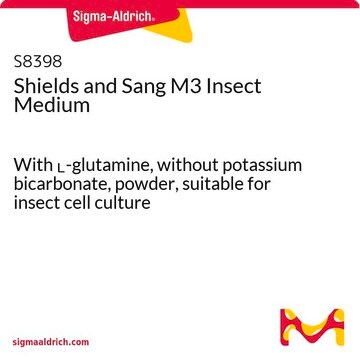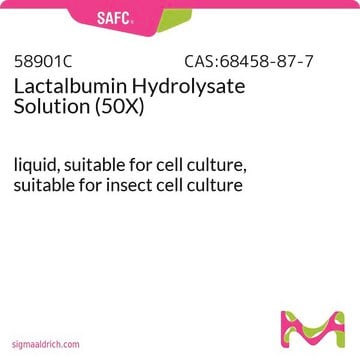This medium has not been evaluated for freezer storage. The thawing process may cause precipitation of some salts. The end user may determine the suitability experimentally by freezing a small test volume. It is advisable to thaw the product slowly to minimize the chance of precipitation. Thaw the sample slowly, overnight in a refrigerator., if possible It will very likely be suitable if the resulting thawed medium is clear, colorless, and free of particulate matter. Do not add serum or supplements prior to freezing the test sample.
S0146
Schneider′s Insect Medium
With ʟ-glutamine and sodium bicarbonate, liquid, sterile-filtered, suitable for insect cell culture
Synonyme(s) :
Schneider’s Drosophila Medium
Sélectionner une taille de conditionnement
Sélectionner une taille de conditionnement
About This Item
Produits recommandés
Nom du produit
Schneider′s Insect Medium, With L-glutamine and sodium bicarbonate, liquid, sterile-filtered, suitable for insect cell culture
Niveau de qualité
Stérilité
sterile-filtered
Forme
liquid
Technique(s)
cell culture | insect: suitable
Adéquation
suitable for culture of other dipteran cell lines (Originally developed for the culture of Drosophila cells)
Composants
NaHCO3: 0.4 g/L
glucose: 2 g/L (Dextro)
L-glutamine: 1.8 g/L
Conditions d'expédition
ambient
Température de stockage
2-8°C
Vous recherchez des produits similaires ? Visite Guide de comparaison des produits
Application
- to culture Drosophila neuronal cell line (BG3-c2 cells)[1]
- to cultivate subcultures of Leishmania major for promastigote growth inhibition assay[2]
- to seed purified ookinetes with Drosophila melanogaster S2 cells to assess the effect of the avermectin compound on cell development and to promote oocyte development[3]
Souvent commandé avec ce produit
Code de la classe de stockage
12 - Non Combustible Liquids
Classe de danger pour l'eau (WGK)
WGK 1
Point d'éclair (°F)
Not applicable
Point d'éclair (°C)
Not applicable
Faites votre choix parmi les versions les plus récentes :
Déjà en possession de ce produit ?
Retrouvez la documentation relative aux produits que vous avez récemment achetés dans la Bibliothèque de documents.
Les clients ont également consulté
-
Is it possible to freeze this medium ? I'll need to use only a few millilitres for each dissections of fly brains so it'll be great if I could freeze it in smaller containers to extend the shelf life period.
1 réponse-
Utile ?
-
Filtres actifs
Notre équipe de scientifiques dispose d'une expérience dans tous les secteurs de la recherche, notamment en sciences de la vie, science des matériaux, synthèse chimique, chromatographie, analyse et dans de nombreux autres domaines..
Contacter notre Service technique







